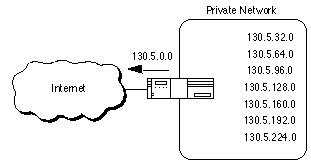




Subnetting
In 1985, RFC 950 defined a standard procedure to support the subnetting, or division, of a single Class A, B, or C network number into smaller pieces. Subnetting was introduced to overcome some of the problems that parts of the Internet were beginning to experience with the classful two-level addressing hierarchy:

Figure 6: Subnet Address Hierarchy
Subnetting attacked the expanding routing table problem by ensuring that the subnet structure of a network is never visible outside of the organization's private network. The route from the Internet to any subnet of a given IP address is the same, no matter which subnet the destination host is on. This is because all subnets of a given network number use the same network-prefix but different subnet numbers. The routers within the private organization need to differentiate between the individual subnets, but as far as the Internet routers are concerned, all of the subnets in the organization are collected into a single routing table entry. This allows the local administrator to introduce arbitrary complexity into the private network without affecting the size of the Internet's routing tables.
Subnetting overcame the registered number issue by assigning each organization one (or at most a few) network number(s) from the IPv4 address space. The organization was then free to assign a distinct subnetwork number for each of its internal networks. This allows the organization to deploy additional subnets without needing to obtain a new network number from the Internet.

Figure 7: Subnetting Reduces the Routing Requirements of the Internet
In Figure 7, a site with several logical networks uses subnet addressing to cover
them with a single /16 (Class B) network address. The router accepts all traffic
from the Internet addressed to network 130.5.0.0, and forwards traffic to the
interior subnetworks based on the third octet of the classful address. The deployment
of subnetting within the
private network provides several benefits:
Unterkapitel: